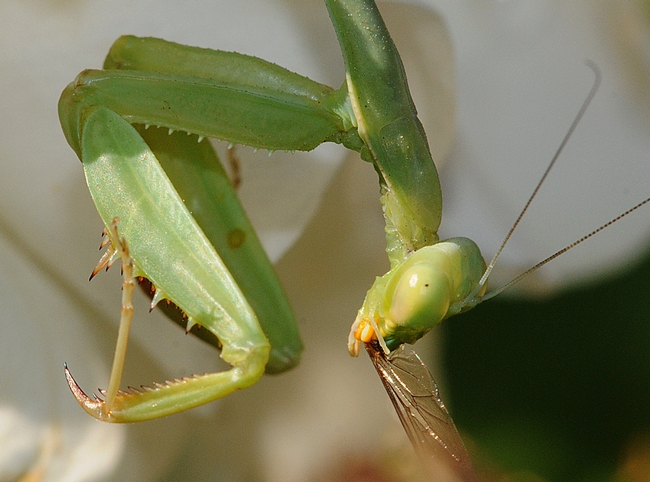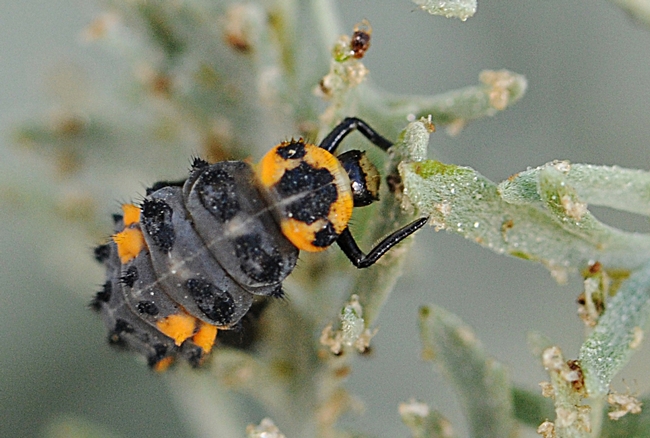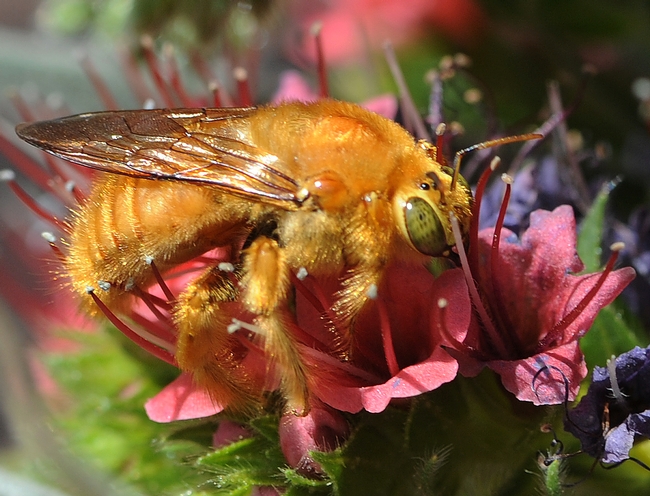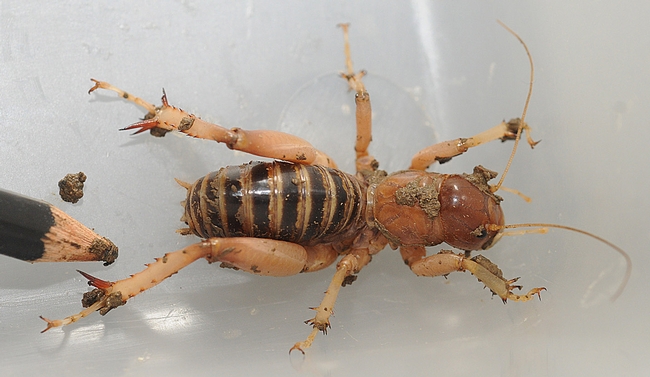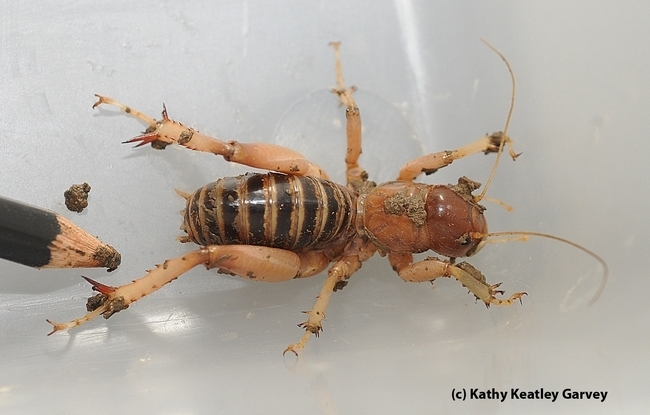- Author: Kathy Keatley Garvey

UC Davis third-year entomology student Sol Wantz, an intern at the Bohart Museum of Entomology, president of the UC Davis Entomology Club, and an undergraduate researcher in the Neal Williams' lab, shed light on "Grasshoppers, Crickets and Katydids" when she delivered a presentation at a recent Bohart Museum open house.
Jerusalem crickets, aka "potato bugs," drew the most interest.
The wingless insects, members of the family, Stenopelmatidae, are omniverous, feeding on both plants and animals, Wantz told the crowd. They are ground-dwelling insects found "mostly in North America, some in Asia and Africa," she said, and they include 7 genera and 67 species.
"They have a unique method of sound production," Wantz said. "They thump their abdomen against the ground to produce a surprisingly loud noise. Their thumping patterns can be used to identify their species."
Sol, who grew up in the Bay Area community of Belmont, is the first entomologist in her family. "My parents and brother all love insects, but I am the only one hoping to make a career out of entomology."
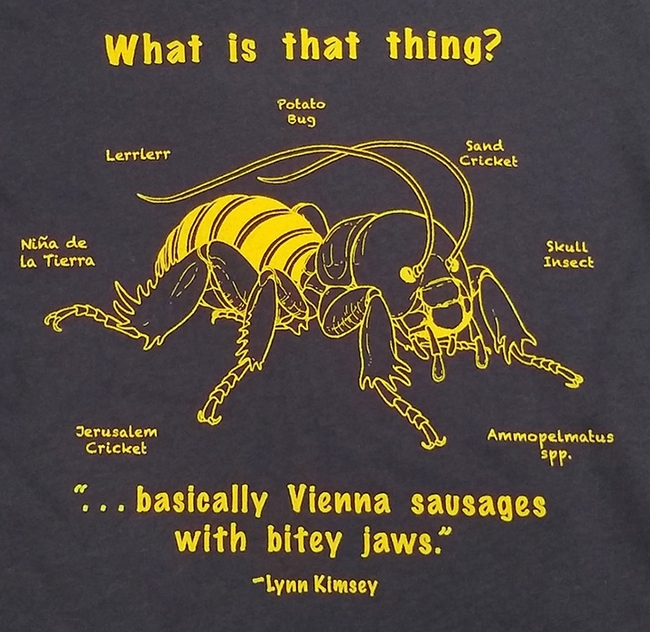
Jerusalem Cricket T-Shirt. The Bohart Museum sells a Jerusalem cricket t-shirt in its gift shop, the result of so many queries beginning with "What is that thing?" Kimsey's humorous answer, "basically Vienna sausages with bitey jaws," appears on the shirt. The art is the work of UC Davis student and Bohart volunteer Allen Chew, and the design by UC Davis doctoral alumnus Professor Fran Keller of Folsom Lake College, a Bohart Museum scientist.
Wantz also discussed grasshoppers and katydids. "The katydid genus Supersonus produces the highest frequency sound of any known animal, up to 150 kHz!" she said. "For reference, humans can only hear between 0 and 20 kHz."
Wantz grew up in the Bay Area community of Belmont. "My parents and brother all love insects, but I am the only one hoping to make a career out of entomology." Her parents, Adam Wantz and Patti Leggett-Wantz, were among those attending the seminar.
The Bohart Museum, located in Room 1124 of the Academic Surge Bulding, 455 Crocker Lane, is directed by Professor Jason Bond, the Evert and Marion Schlinger Endowed Chair in Insect Systematics, UC Davis Department of Entomology and Nematology; and associate dean of the UC Davis College of Agricultural and Environmental Sciences.
Two-Week Public Closure. Due to staff shortage, spring break, and winter quarter finals, the Bohart Museum will be closed to the public (walk-ins) for the next two weeks, Monday, March 18 through Friday, March 29. Previously scheduled group tours will continue to take place those two weeks. For more information, access the website at https://bohart.ucdavis.edu.
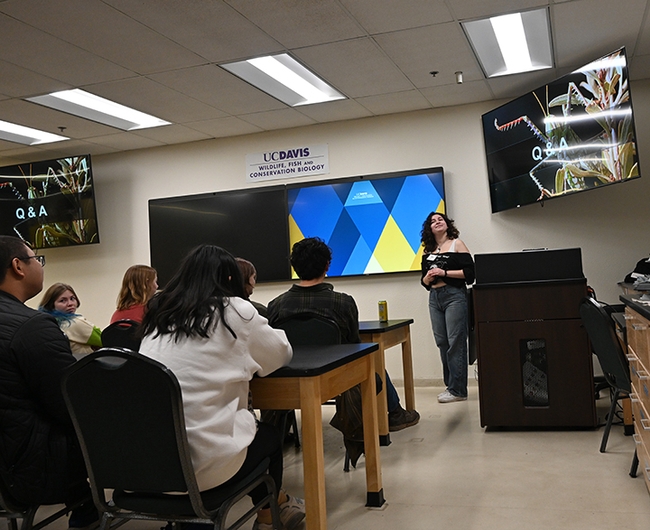
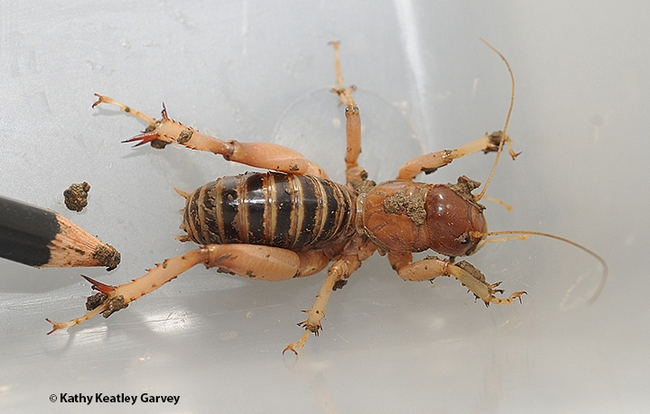
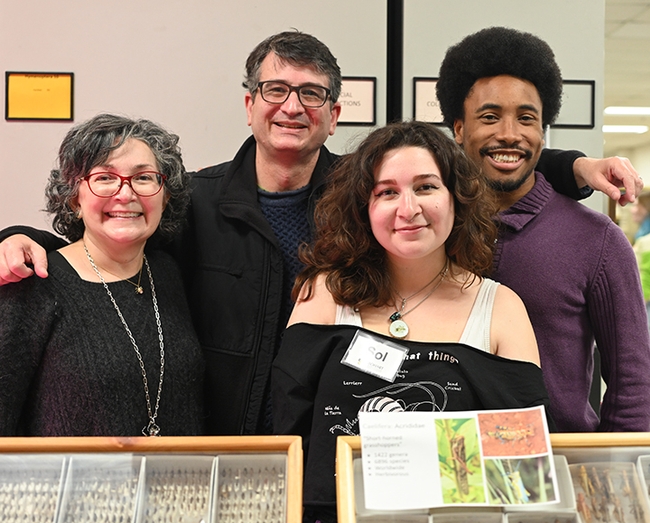
- Author: Kathy Keatley Garvey
With so many folks asking "What are those weird bugs?" and UC Davis distinguished professor Lynn Kimsey, director of the Bohart Museum of Entomology, describing them as "basically Vienna sausages with bitey jaws," it definitely had to happen--a Bohart t-shirt depicting a Jerusalem cricket, aka potato bug, with that analogy.
The art is the work of UC Davis student and Bohart volunteer Allen Chew, and the design by UC Davis doctoral alumnus Professor Fran Keller of Folsom Lake College, a Bohart Museum scientist.
Professor Keller announced that she plans to stock the gift shop with this t-shirt, available in youth and adult sizes, by Friday, July 29, and later, it can be ordered from the Bohart website.
We photographed a Jerusalem cricket in April at the Doran Beach campground, Bodega Bay. Several children on bicycles saw it first and identified it as a "big bee, a big 'un."
At least they didn't call it a "murder hornet." Or a "murder bee."

"Although the officially recognized common name for this insect is Jerusalem Cricket, a number of other names also are used including: 'Potato Bugs', Woh-tzi-Neh ('old bald-headed man') or 'Niña de la Tierra' ('little girl of the earth'). The name 'Potato Bugs' is used because they occasionally will feed on potato tubers. Jerusalem crickets are nocturnal, coming out at night to feed. During the day, particularly in the summer months, they can be found underneath rocks, logs or boards. These crickets are to some extent scavengers, feeding on plant roots and tubers, and sometimes even on dead animal matter. Unlike most other crickets, female Jerusalem Crickets sometimes kill the males after mating. Jerusalem crickets can generate sound by rubbing the back leg against the side of the abdomen (stridulation). These large crickets are an important source of food, particularly during the winter for a number of different birds of prey including barn and burrowing owls and small hawks, like kestrels."

Keller says she has both youth and adult sizes, ranging from small to xxlarge. For adults, the selections are black with white ink; blue with gold ink; and rust with tan ink. The cost? $20, plus tax. For children or youths, the selected color is blue with gold ink. Cost? $17, plus tax. Proceeds benefit the educational projects of the Bohart Museum.
The Bohart, home of a global collection of 8 million insects, a live "petting zoo," and the gift shop, is located in Room 1124 of the Academic Surge Building, 455 Crocker Lane, UC Davis campus. It is open to the public Monday through Thursday, from 9 a.m. to noon, and from 1 to 5 p.m.
Moth Night. In keeping with National Moth Week, the Bohart Museum is planning a Moth Night open house on Saturday, July 30 from 8 p.m. to 11 p.m. The event is free and family friendly. Inside, visitors can see the global collection of moths. Outside, within a short walking distance, they can watch moths and other insects flutter into the blacklighting display, comprised of a hanging white sheet and an ultaviolet (UV) light, powered by a generator.
Also at the open house, folks are invited to bring photos or moth specimens from their house, yard or neighborhood that they would like help in identifying, said Tabatha Yang, education and outreach coordinator. There also will be a craft activity, cookies, and "hot cocoa for anyone who needs help staying up past their bedtime," Yang quipped. The gift shop will be open.
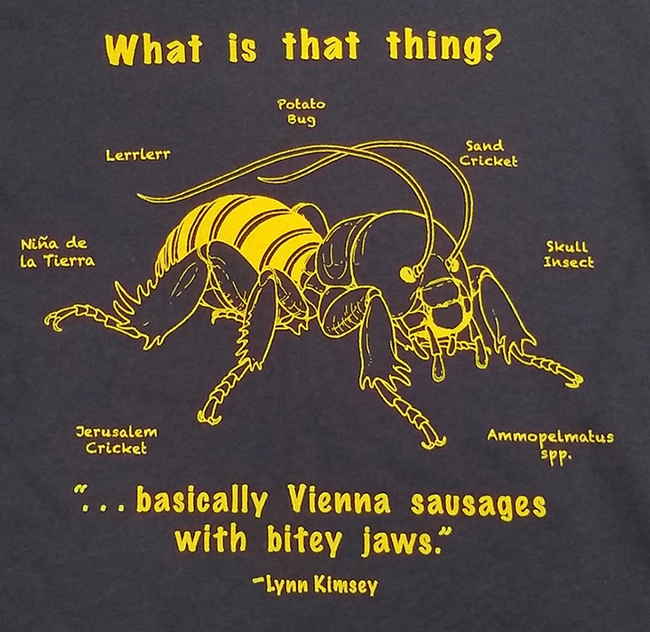
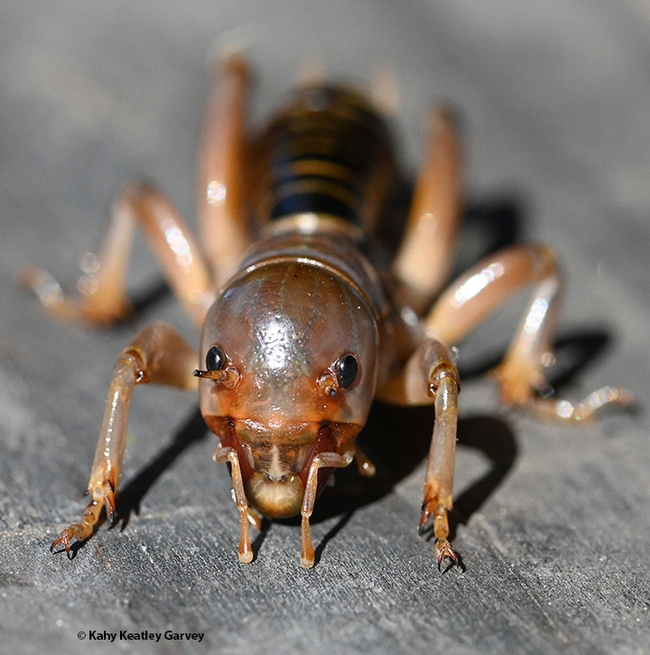
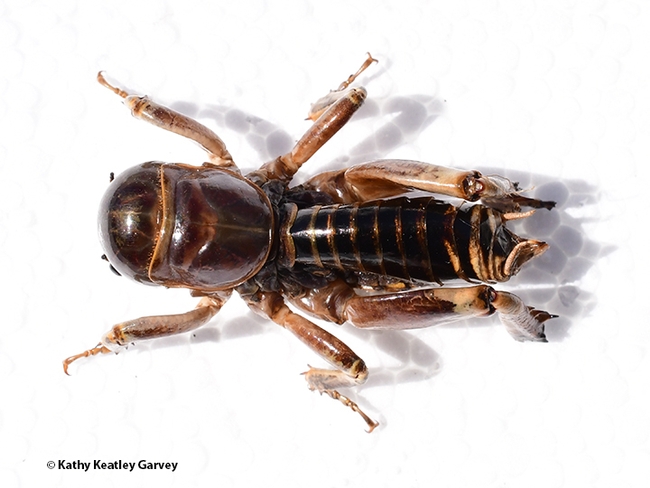
- Author: Kathy Keatley Garvey
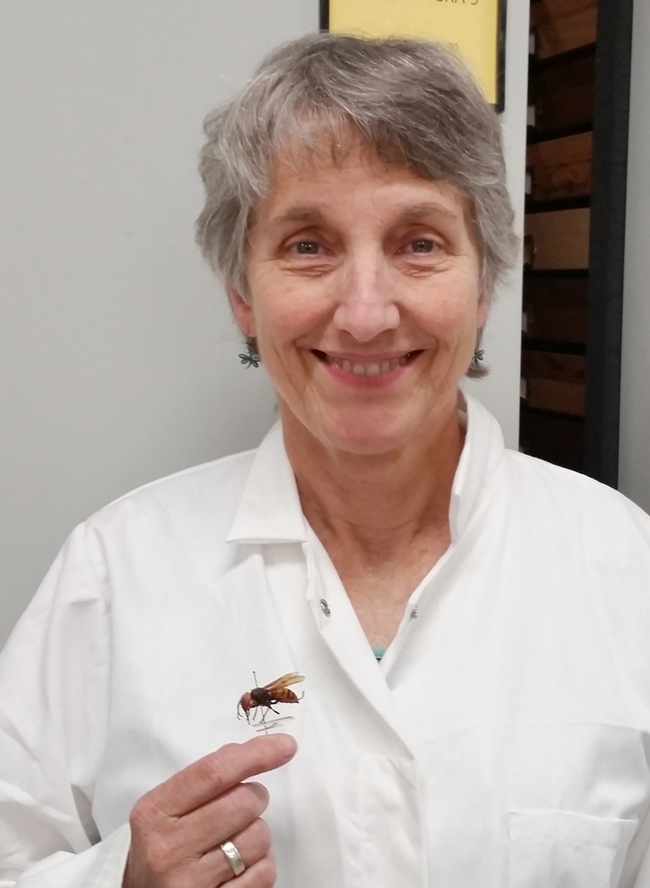
Not even close.
It's a Jerusalem cricket, sometimes called a "potato bug."
The be-on-the-lookout (BOLO) for the Asian giant hornet detected in Canada and Washington state has resulted in scores of queries and submissions of not-even-close specimens.
The poor ol' potato bug gets blamed for being an Asian giant hornet, which the media labeled "the murder hornet." (Wish they wouldn't.)
"Some of the local insects that have been confused with invasive hornets are Jerusalem crickets, bald-faced hornets and cicada killers," says Lynn Kimsey, director of the Bohart Museum of Entomology and professor of entomology, UC Davis Department of Entomology and Nematology.
In a Bohart Fact Sheet, she writes:
"Jerusalem crickets are among the largest insects found in western North America. They range in size from 1-2½ inches long. In North America they are found only west of the Rocky Mountains. The large shiny brown abdomen with dark stripes, large ovoid head, and spiny hind legs are diagnostic features of these crickets. Both juvenile stages and adults are wingless and crawl slowly. These large crickets belong to the family Stenopelmatidae. The most widespread species found in California is Stenopelmatus fuscus. Even though they are essentially harmless, there is considerable mythology about the dangerous nature of these large wingless, ground dwelling insects. Much of this mythology is due to their large size, large, bald humanoid head, and massive jaws. Jerusalem Crickets can bite, so some care should be taken when handling them; otherwise, despite their ferocious appearance, they are harmless. They are also not considered to be agricultural pests, as they do not cause noticeable damage to garden or crop plants.
"Although the officially recognized common name for this insect is Jerusalem Cricket, a number of other names also are used including: "Potato Bugs", Woh-tzi-Neh ("old bald-headed man") or "Niña de la Tierra" ("little girl of the earth"). The name "Potato Bugs" is used because they occasionally will feed on potato tubers. Jerusalem crickets are nocturnal, coming out at night to feed. During the day, particularly in the summer months, they can be found underneath rocks, logs or boards. These crickets are to some extent scavengers, feeding on plant roots and tubers, and sometimes even on dead animal matter. Unlike most other crickets, female Jerusalem Crickets sometimes kill the males after mating. Jerusalem crickets can generate sound by rubbing the back leg against the side of the abdomen (stridulation). These large crickets are an important source of food, particularly during the winter for a number of different birds of prey including barn and burrowing owls and small hawks, like kestrels."
Kimsey, a noted authority on Hymenoptera (bees and wasps) and a past president of the International Society of Hymenopterists, is highly sought for her expertise on the Asian giant hornet.
And now, in a collaborative project with the U.S. Department of Agriculture (USDA), the Bohart Museum scientists are imaging insect specimens misidentified as the invasive hornet. The Bohart Museum houses a dual system, a GIGA macro system and a Leica microsope system, the later necessary for imaging smaller insects. "Examples of smaller insects," Kimsey says, "would be some of the parasitoid wasps which can be 1 mm in length. Both systems can offer images at 100x life size."
"Ultimately these images will be used to educate and train inspectors and USDA agents who are tasked with intercepting invasive insects in cargo loads and shipping containers from around the world," Kimsey says.
Now give the poor ol' potato bug a break. It is NOT the Asian giant hornet...and please don't call it a murder cricket.
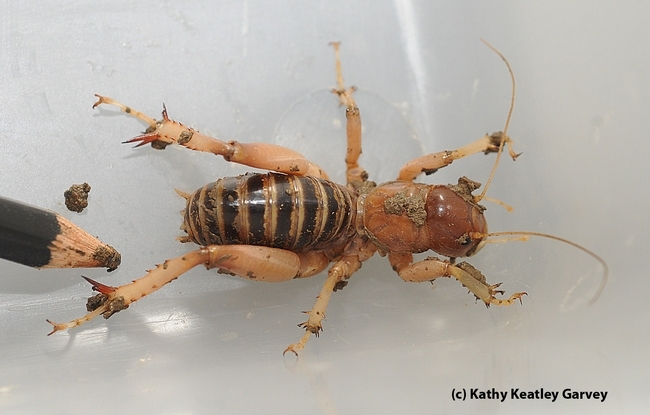
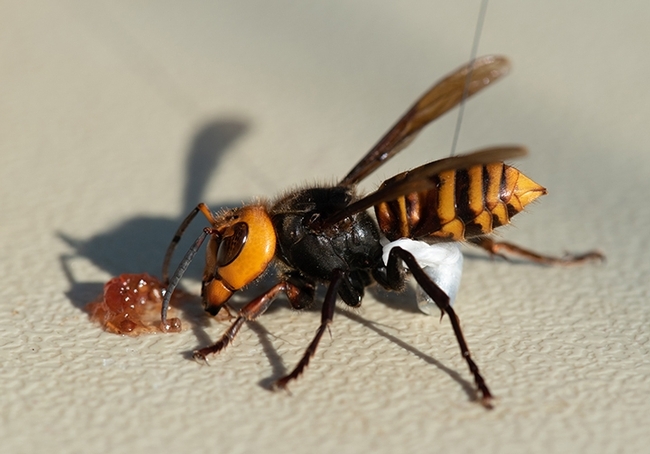
- Author: Kathy Keatley Garvey
It's a strange little insect.
A reader likens it to "a cricket on steroids."
A Van Nuys resident says she always wondered what they were. "I've lived in this house for 17 years, and a few times a year I see this strange insect in my backyard. It is always either dead or dying. It has a really large head and seems to be a bit top-heavy and has problems walking. I have never seen these insects anywhere but in my backyard and no one seems to know what they are. I feel badly for the little critters, since they don't seem to be thriving."
A Vacaville resident encountered this "unknown species of insect" in her backyard. Her dog discovered the first one. Dead. She discovered the second. Alive.
Guess what they found? A Jerusalem cricket, also known as a "potato bug" because it occasionally feeds on potato tubers.
They're among the largest insects found in California and elsewhere in western North America, says Lynn Kimsey, director of the Bohart Museum of Entomology and professor of entomology at UC Davis.
The adult is characterized by its "large shiny brown abdomen with dark stripes, large ovoid head and spiny hind legs."
These ground dwellers crawl (slowly) but they don't fly. They belong to the family Stenopelmatidae. The common species found in California is Stenopelmatus fuscus, Kimsey says.
Kimsey also says they are harmless, although if you handle them, they may bite.
So when you're digging around in your backyard, you may find them under rocks, logs or boards. They feed on plant roots and tubers. "They generate sound by rubbing the hind leg against the side of the abdomen (stridulation)," Kimsey says.
In her Fact Sheet on Jerusalem Crickets posted on the Bohart Museum website: Kimsey points out that "Unlike most other crickets, female Jerusalem crickets frequenty kill the males after mating."
Ah, a touch of the praying mantis behavior!
We've seen Jerusalem crickets beneath the grounds of the Harry H. Laidlaw Jr. Honey Bee Research Facility on Bee Biology Road, UC Davis. We've also seen their predators: birds of prey, including owls and hawks, but never the prey and predator together.
Seems like a tasty treat for a burrowing owl.
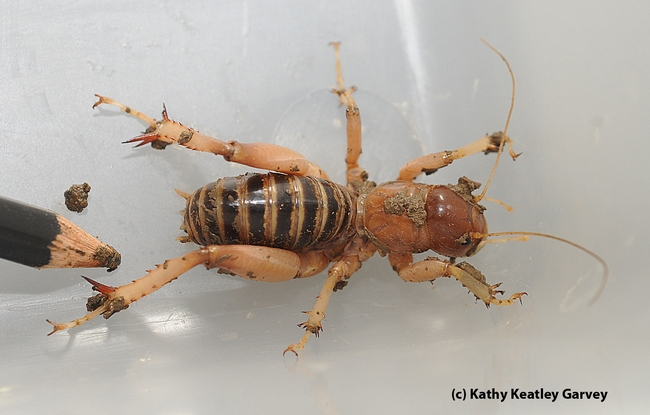
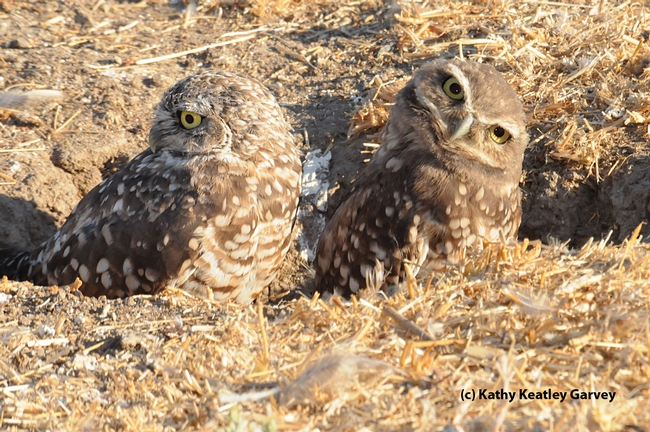
- Author: Kathy Keatley Garvey
If you don't know what it is, don't kill it.
That insect in your garden could very well be a beneficial insect.
If you operate on the "shoot-first-ask-questions later" or "the only good bug is a dead bug," no telling how many insects--and generations--you'll be destroying.
Butterfly expert Art Shapiro, professor of evolution and ecology at UC Davis, tells this story that's worth remembering.
"Last week I was walking across Capitol Park in Sacramento when I observed a smartly dressed young woman in her 20s stomp a praying mantis and grind it into the sidewalk. She exclaimed to her phenotypically similar friend: 'Did you ever see such an ugly, icky bug?'"
And, many years ago, Shapiro encountered a man in College Park, Davis, in the act of stomping a Tiger Swallowtail.
Shapiro asked him why he was doing this.
The man replied: "This is the bug that has the big green caterpillar that eats my tomato plants!"
When Shapiro told him it wasn't, the man told him to check his information, and that "I'm right and you're wrong."
There is indeed a lot of misinformation and misidentification out there.
Tabatha Yang of the Bohart Museum of Entomology at UC Davis relates the story about an avid gardener who absolutely loved ladybugs (aka lady beetles) because of their voracious appetites for aphids. But when our avid gardener came across "some weird black and orange bugs," she promptly killed them.
Little did she know that she was killing immature ladybugs.
Then there's the story about a UC Master Gardener who encountered a "green-eyed golden bumblebee-like" insect that frightened her because it buzzed so loudly around her flower beds. So, she killed it. Turns out it was a pollinator, a male Valley carpenter bee, also known as a "teddy bear."
And, can you imagine what goes through people's minds when they meet up with a Jerusalem cricket in the mud after a rain? Whoa! Bug-o-mania!
Here's where the Bohart Museum, 1124 Academic Surge on California Drive, UC Davis campus, can help. If you live in California and see an insect and wonder if it's beneficial insect or a pest--or just want to know what it is--take a photo of it and email it to the Bohart. Lynn Kimsey, director of the Bohart Museum (home of more than seven million specimens) and professor of entomology at UC Davis, identifies insects in between research, teaching, administering the Bohart Museum, and other duties. Her email address: lskimsey@ucdavis.edu.
In fact, if you go to the UC Davis Department of Entomology home page and scroll down to the bottom you'll see:
"Do you have an insect question? Ask It Here!"
Maybe, just maybe, this will save a few praying mantids, ladybugs, Valley carpenter bees and Jerusalem crickets.
